ComfyUI Node: IF Video Prompts 🎥🧠
VideoPromptNode
CategoryImpactFrames💥🎞️/LLM
impactframes (Account age: 3184days) Extension
IF_VideoPrompts Latest Updated
2025-04-02 Github Stars
0.04K
How to Install IF_VideoPrompts
Install this extension via the ComfyUI Manager by searching for IF_VideoPrompts- 1. Click the Manager button in the main menu
- 2. Select Custom Nodes Manager button
- 3. Enter IF_VideoPrompts in the search bar
Visit ComfyUI Online for ready-to-use ComfyUI environment
- Free trial available
- 16GB VRAM to 80GB VRAM GPU machines
- 400+ preloaded models/nodes
- Freedom to upload custom models/nodes
- 200+ ready-to-run workflows
- 100% private workspace with up to 200GB storage
- Dedicated Support
IF Video Prompts 🎥🧠 Description
Versatile video analysis tool with frame-based and direct video modes, generating descriptive prompts and scene analyses for AI artists.
IF Video Prompts 🎥🧠:
The VideoPromptNode is a versatile tool within the ComfyUI framework designed to analyze video sequences or files using advanced Qwen2.5-VL multimodal models. This node offers two primary modes of operation: frame-based mode, which processes pre-loaded frames from LoadVideo nodes, and direct video mode, which handles video files directly. Its capabilities include generating descriptive prompts for video content, conducting comprehensive scene analyses, breaking down key scenes, and creating negative prompts based on configured templates. By leveraging these features, the node provides AI artists with insightful and detailed textual descriptions of video content, enhancing their ability to understand and creatively engage with video data.
IF Video Prompts 🎥🧠 Input Parameters:
profile
This parameter allows you to select a predefined profile that includes a system prompt and specific rules for video analysis. The default profile is "HyVideoAnalyzer
- Simple one line prompt," which provides a straightforward analysis approach. Profiles help tailor the analysis to specific needs or styles.
max_new_tokens
This integer parameter sets the maximum number of new tokens the model can generate during analysis. It ranges from 1 to 2048, with a default value of 512. Adjusting this value can impact the length and detail of the generated prompts.
frame_sample_count
This integer parameter determines the number of frames sampled from the video sequence for analysis. It ranges from 1 to 32, with a default of 16. Increasing the count can provide a more comprehensive analysis but may require more processing power.
temperature
A float parameter that controls the randomness of the generated text. It ranges from 0.0 to 2.0, with a default of 0.7. Higher values increase creativity but may reduce coherence, while lower values produce more deterministic outputs.
analysis_type
This parameter specifies the type of analysis to perform, with options including "Full sequence," "Key scenes," and "Single summary." The default is "Full sequence," which provides a detailed analysis of the entire video.
language
This parameter sets the language for the output, with options for "English" and "Chinese." The default is "English," allowing you to receive prompts in your preferred language.
images
An optional parameter that accepts input frames from a LoadVideo node. These frames are used in frame-based mode for analysis.
video_file
An optional parameter that allows you to select a video file from the input directory for direct video mode processing.
fps
This float parameter sets the frames per second for video processing, ranging from 0.1 to 60.0, with a default of 8.0. Higher values sample more frames, potentially improving analysis quality.
max_pixels
An integer parameter that defines the maximum number of pixels for video processing, with a default of 512512. It ranges from 0 to 1280720, and setting it to 0 uses the default resolution.
fallback_frame_count
This integer parameter specifies the number of frames to use in fallback mode if initial processing fails. It ranges from 1 to 16, with a default of 4. Lower values use less VRAM, which can be beneficial for resource-constrained environments.
custom_system_prompt
An optional string parameter that allows you to provide a custom system prompt to override the selected profile. This can be useful for tailoring the analysis to specific requirements.
prefix
An optional string parameter that adds text before the generated prompt, allowing for customization of the output.
suffix
An optional string parameter that adds text after the generated prompt, providing additional customization options.
seed
An integer parameter for setting a random seed for generation, with a default of -1 for random. This can be used to ensure reproducibility of results.
negative_prompt
This parameter allows you to select a predefined negative prompt to use, which can help refine the analysis by excluding certain elements.
model_offload
A parameter with options "Yes" or "No" that determines whether to offload the model from the GPU when not in use, saving VRAM. The default is "Yes."
precision
This parameter sets the model precision, with options "float16," "bfloat16," and "float32." The default is "float16," balancing performance and resource usage.
IF Video Prompts 🎥🧠 Output Parameters:
generated_text
The primary output of the node is a generated text prompt that captures the essence of the analyzed video content. This text can include descriptive prompts, scene analyses, and key scene breakdowns, providing valuable insights into the video.
IF Video Prompts 🎥🧠 Usage Tips:
- To achieve a more detailed analysis, increase the
frame_sample_countto capture more frames from the video sequence. - Use the
temperatureparameter to adjust the creativity of the generated text. A higher temperature can lead to more imaginative descriptions, while a lower temperature ensures more consistent outputs. - If you have specific analysis requirements, consider using the
custom_system_promptto tailor the system prompt to your needs. - For resource-constrained environments, set
model_offloadto "Yes" to save VRAM when the model is not in use.
IF Video Prompts 🎥🧠 Common Errors and Solutions:
Failed to analyze video: <error_message>
- Explanation: This error occurs when the node encounters an issue during video analysis, possibly due to incorrect input parameters or unsupported video formats.
- Solution: Verify that the input video file or frames are correctly formatted and supported by the node. Check the input parameters for any inconsistencies or errors.
Model loading error
- Explanation: This error indicates a problem with loading the Qwen2.5-VL model, which may be due to insufficient VRAM or incorrect model settings.
- Solution: Ensure that your system has enough VRAM to load the model. Consider adjusting the
precisionparameter to a lower setting, such as "float16," to reduce VRAM usage.
IF Video Prompts 🎥🧠 Related Nodes
RunComfy is the premier ComfyUI platform, offering ComfyUI online environment and services, along with ComfyUI workflows featuring stunning visuals. RunComfy also provides AI Playground, enabling artists to harness the latest AI tools to create incredible art.




